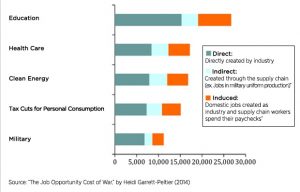The Job Opportunity Cost of War – Heidi Garrett Peltier
Military spending by the federal government is often considered a vital support to employment and economic recovery.
However, military spending creates fewer jobs than the same amount of money would have, if invested in other sectors. Clean energy and health care spending create 50 percent more jobs than the equivalent amount of spending on the military. Education spending creates more than twice as many jobs.
There are three reasons why this is the case. Industries such as education and clean energy are more labor-intensive. For a given level of spending, more of those dollars go toward hiring workers and less on equipment and materials. Also, a greater percentage of spending in education, health care, and clean energy construction stays within the US, creating more domestic jobs. Military personnel spend more of their earnings abroad and foreign contractors and employees get some portion of Pentagon spending. Finally, since wages and benefits are lower in those sectors than they are for military contractors and personnel on average, the same amount of money hires more people in those non-military sectors.
As a result, if over the years 2001-2014 the US had not been at war but instead had channeled resources into expanding the clean energy industry, broadening health care coverage, and increasing educational opportunities, between 1 and 3 million more jobs would have been created, reducing unemployment significantly.

The Job Opportunity Cost of War – Heidi Garrett Peltier – 2014 and 2017
Job Opportunity Cost of War – HGP – FINAL – 2017
